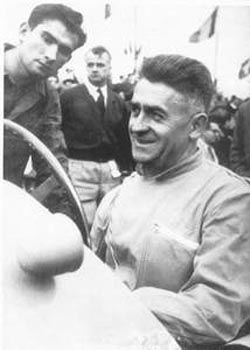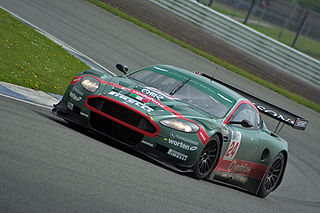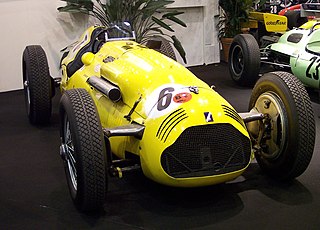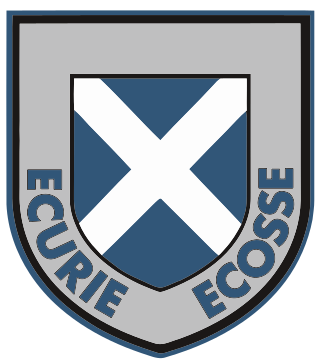
Olivier Jean Marie Fernand Gendebien was a Belgian racing driver who was called "one of the greatest sportscar racers of all time".

The 1952 Belgian Grand Prix was a Formula Two race held on 22 June 1952 at Circuit de Spa-Francorchamps. It was race 3 of 8 in the 1952 World Championship of Drivers, in which each Grand Prix was run to Formula Two rules rather than the Formula One regulations normally used.

The 1952 Dutch Grand Prix was a Formula Two race held on 17 August 1952 at the Circuit Zandvoort. It was race 7 of 8 in the 1952 World Championship of Drivers, in which each Grand Prix was run to Formula Two rules rather than the Formula One regulations normally used. The 90-lap race was won by Ferrari driver Alberto Ascari after he started from pole position. His teammates Giuseppe Farina and Luigi Villoresi finished in second and third places. Ascari overtook Fangio's record for the most race wins, scoring his seventh at this race.

The 1952 Italian Grand Prix was a Formula Two race held on 7 September 1952 at Monza. It was the eighth and final round of the 1952 World Championship of Drivers, in which each Grand Prix was run to Formula Two rules rather than the Formula One regulations normally used. The 80-lap race was won by Ferrari driver Alberto Ascari after he started from pole position. José Froilán González finished second for the Maserati team and Ascari's teammate Luigi Villoresi came in third.

The 1953 Belgian Grand Prix was a Formula Two race held on 21 June 1953 at Circuit de Spa-Francorchamps. It was race 4 of 9 in the 1953 World Championship of Drivers, which was run to Formula Two rules in 1952 and 1953, rather than the Formula One regulations normally used. The 36-lap race was won by Ferrari driver Alberto Ascari after he started from second position. His teammate Luigi Villoresi finished second and Maserati driver Onofre Marimón came in third.

The 1954 Belgian Grand Prix was a Formula One motor race held at Spa-Francorchamps on 20 June 1954. It was race 3 of 9 in the 1954 World Championship of Drivers. The 36-lap race was won by Maserati driver Juan Manuel Fangio after he started from pole position. Maurice Trintignant finished second for the Ferrari team with Fangio's teammate Stirling Moss in third.

Louis Rosier was a racing driver from France.

BMS Scuderia Italia SpA is an Italian auto racing team founded by Italian steel magnate and motorsports enthusiast Giuseppe Lucchini in 1983. Initially named Brixia Motor Sport (BMS) the team briefly entered the World Touring Car Championship, the team's name was altered to BMS Scuderia Italia upon their entrance into Formula One in 1988. After departing Formula One in 1993, BMS Scuderia Italia has been involved in touring car racing and sports car racing.

Charles de Tornaco was a racing driver from Belgium. He participated in 4 Formula One World Championship Grands Prix, debuting on 22 June 1952. He scored no championship points.
Élie Marcel Bayol was a French racing driver who raced in Formula One for the O.S.C.A. and Gordini teams. Bayol also raced sports cars, mostly driving DB-Panhards for the Deutsch Bonnet works team including winning the 750cc class and Index of Performance at the 1954 24 Hours of Le Mans.

Marius Eugène Chaboud was a French racing driver. He participated in three Formula One World Championship Grands Prix, scoring one championship point. He also participated in numerous non-Championship Formula One races.

Jacques Swaters was a racing driver from Belgium and former team owner of Ecurie Francorchamps and Ecurie Nationale Belge.

Octave John Claes was an English-born racing driver who competed for Belgium. Before his fame as a racing driver, Claes was also a jazz trumpeter and successful bandleader in Britain.

The 1962 24 Hours of Le Mans was the 30th Grand Prix of Endurance, and took place on 23 and 24 June 1962. It was the eighth round of the new 1962 International Championship of Manufacturers.

Ecurie Ecosse was a motor racing team from Edinburgh, Scotland. The team was founded in November 1951 by Edinburgh businessman and racing driver David Murray and mechanic Wilkie Wilkinson. Its most notable achievement was winning the 1956 and the 1957 24 Hours of Le Mans. The team also raced in three Formula One races. Ecurie Ecosse's cars were always distinctive in their flag blue metallic paint.
Elton Julian is an American racecar driver and team owner. After driving at the International Formula 3000 and the FIA World Endurance Championship, he has entered DragonSpeed at the FIA WEC, WeatherTech SportsCar Championship, European Le Mans Series and IndyCar Series.

The 1953 24 Heures de Spa Francorchamps took place on 25 and 26 July 1953, at the Circuit de Spa-Francorchamps, (Belgium). It was also the fourth round of the FIA World Sports Car Championship. This was the first time the event had taken place since Luigi Chinetti and Jean Lucas won in 1949. The race was not run again until 1964.

The Ferrari 212 F1 was a Formula 1 and Formula 2 racing car designed by Aurelio Lampredi for Scuderia Ferrari in 1951.
José Behra was a French racing driver and rally driver.
Auguste Veuillet, known as Toto Veuillet, was a French racing driver and founder of Sonauto, France's first importer of Porsche cars and Yamaha motorcycles. He drove Porsche's first Le Mans entry and took their first two class wins along with Edmond Mouche.












